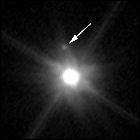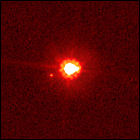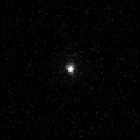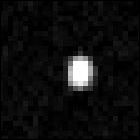The moon of Makemake
 Astronomers reveal that Makemake, an icy dwarf planet orbiting in the distant Kuiper Belt region of the solar system, has a moon, first spotted in 2015 by a team using the Hubble Space Telescope. (The news comes just days after the 26th anniversary of Hubble’s launch.) With an estimated diameter of 100 miles (compared to the 870 mile diameter of its parent body), the satellite orbits Makemake at a distance of 13,000 miles, taking twelve days to complete one orbit. Previous observations failed to pick up on the dark, dim body due to the relatively bright glare of Makemake itself.
Astronomers reveal that Makemake, an icy dwarf planet orbiting in the distant Kuiper Belt region of the solar system, has a moon, first spotted in 2015 by a team using the Hubble Space Telescope. (The news comes just days after the 26th anniversary of Hubble’s launch.) With an estimated diameter of 100 miles (compared to the 870 mile diameter of its parent body), the satellite orbits Makemake at a distance of 13,000 miles, taking twelve days to complete one orbit. Previous observations failed to pick up on the dark, dim body due to the relatively bright glare of Makemake itself.
Eris
 Astronomers at Palomar Observatory discover a body beyond Neptune’s orbit that initial observations show is larger than Pluto. Eris is quickly dubbed the tenth planet by the media and the scientific community, and it is later found to have a small moon of its own in a close orbit, which is later named Dysnomia. But events overtake Eris and Dysnomia before the science textbooks have a chance to be rewritten to include a tenth planet: Eris becomes a case study in an ongoing debate within the International Astronomical Union about the definition of a planet. In 2006, the IAU will establish a set of parameters which determine that Eris isn’t a planet – and then rewrites the history books by deciding that Pluto isn’t either.
Astronomers at Palomar Observatory discover a body beyond Neptune’s orbit that initial observations show is larger than Pluto. Eris is quickly dubbed the tenth planet by the media and the scientific community, and it is later found to have a small moon of its own in a close orbit, which is later named Dysnomia. But events overtake Eris and Dysnomia before the science textbooks have a chance to be rewritten to include a tenth planet: Eris becomes a case study in an ongoing debate within the International Astronomical Union about the definition of a planet. In 2006, the IAU will establish a set of parameters which determine that Eris isn’t a planet – and then rewrites the history books by deciding that Pluto isn’t either.
Sedna
 Astronomers using NASA’s Spitzer Space Telescope announce the discovery a tiny planet, with a diameter of only 2,000 kilometers, orbiting the sun three billion kilometers past Pluto. That places it at an average ten billion kilometers away from Earth – with a solar year that lasts around 10,000 years. Sedna is also spotted from ground-based telescopes as well, using the initial observations made by the Spitzer Telescope; its diameter, only 300 kilometers less than that of Pluto, intensifies the “Pluto as a planet” debate that has been raging since the discovery of Quaoar.
Astronomers using NASA’s Spitzer Space Telescope announce the discovery a tiny planet, with a diameter of only 2,000 kilometers, orbiting the sun three billion kilometers past Pluto. That places it at an average ten billion kilometers away from Earth – with a solar year that lasts around 10,000 years. Sedna is also spotted from ground-based telescopes as well, using the initial observations made by the Spitzer Telescope; its diameter, only 300 kilometers less than that of Pluto, intensifies the “Pluto as a planet” debate that has been raging since the discovery of Quaoar.
Quaoar
 NASA’s Hubble Space Telescope spots an object beyond the orbit of Pluto, and approximately half the size of Pluto – the largest object discovered in the solar system in over 70 years. With a circular orbit that’s a billion miles further from the sun than Pluto, the body is determined to be approximately 800 miles in diameter. Quaoar is believed to be the largest Kuiper Belt object discovered to date, though its thunder will be stolen a few years later with the discovery of Eris and the demotion of Pluto to a dwarf planet.
NASA’s Hubble Space Telescope spots an object beyond the orbit of Pluto, and approximately half the size of Pluto – the largest object discovered in the solar system in over 70 years. With a circular orbit that’s a billion miles further from the sun than Pluto, the body is determined to be approximately 800 miles in diameter. Quaoar is believed to be the largest Kuiper Belt object discovered to date, though its thunder will be stolen a few years later with the discovery of Eris and the demotion of Pluto to a dwarf planet.